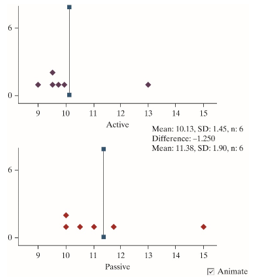Multiple Choice
When newborns are held so that their feet just barely touch the floor, they will make instinctive walking and placing motions. This reflex disappears by about eight weeks. Researchers wanted to know if stimulating this behavior in infants during their first eight weeks of life would lead them to walk at an earlier age compared to infants who do not receive this stimulation. To test this they had twelve infants randomly assigned to two groups. Six infants received stimulation of the walking and placing reflex (active group) and six infants receive equal amounts of gross motor and social stimulation, but did not received stimulation of the walking and placing reflex (passive group) . The researchers then compared the infant's age (in months) when they first walked and the results are shown in the following figure. 
-Which of the following applets would be most appropriate to use, in the context of this study?
A) One Proportion
B) One Mean
C) Multiple Proportions
D) Multiple Means
E) Matched Pairs F. Theory-Based Inference
Correct Answer:

Verified
Correct Answer:
Verified
Q21: In order to investigate whether talking on
Q22: In order to investigate whether talking on
Q23: An article that appeared in the British
Q24: An article that appeared in the British
Q25: Monthly snowfall (in inches) was measured over
Q27: Monthly snowfall (in inches) was measured over
Q28: A researcher asked random samples of 50
Q29: In order to investigate whether talking on
Q30: Monthly snowfall (in inches) was measured over
Q31: When newborns are held so that their